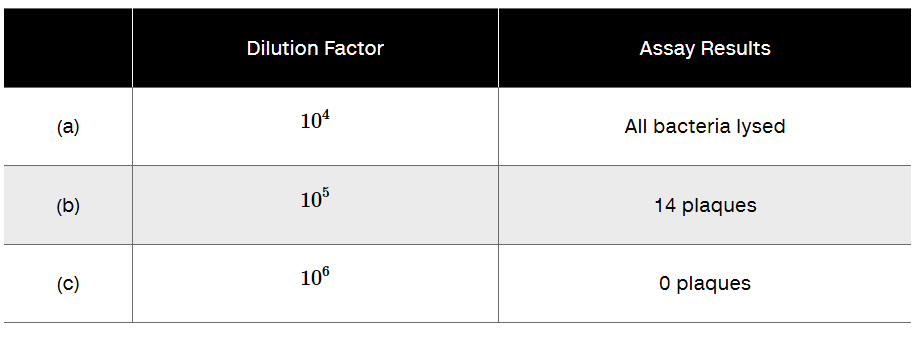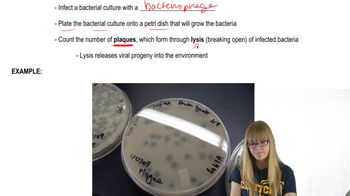Two theoretical genetic strains of a virus (a⁻b⁻c⁻ and a⁺b⁺c⁺) were used to simultaneously infect a culture of host bacteria. Of 10,000 plaques scored, the following genotypes were observed. Determine the genetic map of these three genes on the viral chromosome. Decide whether the interference was positive or negative.
Table of contents
- 1. Introduction to Genetics51m
- 2. Mendel's Laws of Inheritance3h 37m
- 3. Extensions to Mendelian Inheritance2h 41m
- 4. Genetic Mapping and Linkage2h 28m
- 5. Genetics of Bacteria and Viruses1h 21m
- 6. Chromosomal Variation1h 48m
- 7. DNA and Chromosome Structure56m
- 8. DNA Replication1h 10m
- 9. Mitosis and Meiosis1h 34m
- 10. Transcription1h 0m
- 11. Translation58m
- 12. Gene Regulation in Prokaryotes1h 19m
- 13. Gene Regulation in Eukaryotes44m
- 14. Genetic Control of Development44m
- 15. Genomes and Genomics1h 50m
- 16. Transposable Elements47m
- 17. Mutation, Repair, and Recombination1h 6m
- 18. Molecular Genetic Tools19m
- 19. Cancer Genetics29m
- 20. Quantitative Genetics1h 26m
- 21. Population Genetics50m
- 22. Evolutionary Genetics29m
5. Genetics of Bacteria and Viruses
Bacteriophage Genetics
Problem 16
Textbook Question
If a single bacteriophage infects one E. coli cell present on a lawn of bacteria and, upon lysis, yields 200 viable viruses, how many phages will exist in a single plaque if three more lytic cycles occur?

 Verified step by step guidance
Verified step by step guidance1
Understand the problem: A single bacteriophage infects one E. coli cell and produces 200 viable viruses after one lytic cycle. We need to find how many phages will be present after three additional lytic cycles.
Recall that each lytic cycle multiplies the number of phages by the burst size (number of viruses produced per infected cell). Here, the burst size is 200.
Set up the calculation: After the first infection, there are 200 phages. After one more lytic cycle, the number of phages will be multiplied by 200 again, and this repeats for each additional cycle.
Express the total number of phages after three more lytic cycles as an exponential growth: \$200^{n}\(, where \)n\( is the number of cycles. Since we start with 200 after the first cycle, after three more cycles, the total phages will be \)200 \times 200^{3}$.
Calculate the total number of phages by multiplying the initial burst size by itself for the number of additional cycles, i.e., \$200^{4}$, but do not compute the final number as per instructions.
 Verified video answer for a similar problem:
Verified video answer for a similar problem:This video solution was recommended by our tutors as helpful for the problem above
Video duration:
1mPlay a video:
Was this helpful?
Key Concepts
Here are the essential concepts you must grasp in order to answer the question correctly.
Lytic Cycle of Bacteriophages
The lytic cycle is a viral replication process where a bacteriophage infects a bacterial cell, replicates its genome, produces new phage particles, and causes the host cell to lyse, releasing progeny viruses. Each cycle results in a burst of new phages, quantified as the burst size.
Recommended video:
Guided course

Bacteriophage Life Cycle
Burst Size
Burst size refers to the number of new phage particles released from a single infected bacterial cell after lysis. It is a critical parameter for calculating phage population growth during successive lytic cycles, as each cycle multiplies the phage count by the burst size.
Recommended video:
Guided course

Bacteriophage Life Cycle
Plaque Formation and Dilution Assays
Plaques are clear zones on a bacterial lawn caused by phage-induced lysis of bacteria. Dilution assays help quantify phage concentration by counting plaques at different dilution factors, linking the number of plaques to the number of infectious phage particles in the sample.
Recommended video:
Guided course

Plaques and Experiments

 3:44m
3:44mWatch next
Master Plaques and Experiments with a bite sized video explanation from Kylia
Start learningRelated Videos
Related Practice
Textbook Question
575
views
